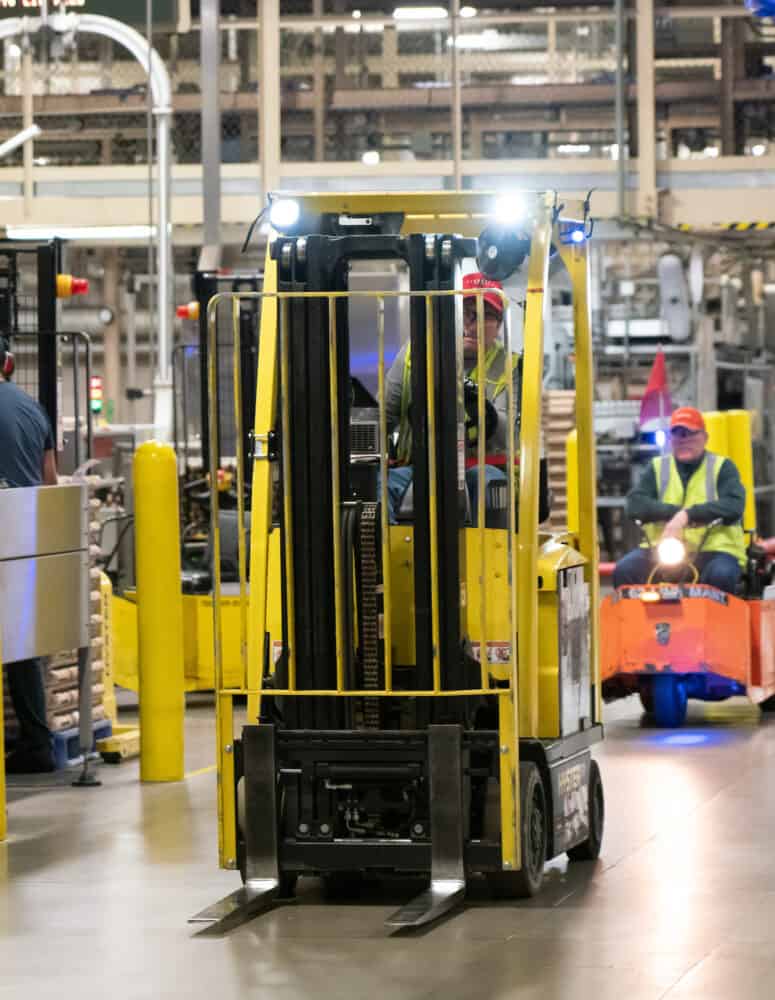Announcing the 2023 Manufacturing Leadership Award Finalists

The Manufacturing Leadership Council—the NAM’s digital transformation division—has announced the finalists for the 2023 Manufacturing Leadership Awards, the industry’s premier awards program for achievements in digital manufacturing. You can read the complete list of finalists here.
The ceremony: The finalists will be honored at the Manufacturing Leadership Awards Gala in Marco Island, Florida, on June 28.
- Also announced at the gala will be winners for all project and individual categories, winners of the Manufacturing in 2030 Award, the Manufacturing Leader of the Year, the Small/Medium Enterprise Manufacturer of the Year and the Large Enterprise Manufacturer of the Year.
Rethink: Certain award winners will also present at Rethink, the industry’s leading event for exploring manufacturing’s digital era, which will also take place in Marco Island on June 26–28.
The categories: The awards are divided into nine project categories to recognize company achievements:
- Artificial Intelligence and Machine Learning
- Collaborative Ecosystems
- Digital Network Connectivity
- Digital Supply Chains
- Engineering and Production Technology
- Enterprise Technology Integration
- Operational Excellence
- Sustainability and the Circular Economy
- Transformational Business Cultures
Additionally, individual leaders are recognized in the Digital Transformation Leadership and Next-Generation Leadership categories.
The last word: “As more manufacturers extend digital’s reach onto the factory floor and throughout their operations, we are witnessing transformative performance improvements that would have been unthinkable just a few short years ago—and that are improving life for employees and customers alike,” said MLC Co-Founder, Vice President and Executive Director David R. Brousell.
Congratulations to the 2023 Manufacturing Leadership Award Finalists
Finalists and winners to be recognized at gala on June 28
Washington, D.C. – The Manufacturing Leadership Council, a division of the National Association of Manufacturers, today revealed the list of world-class manufacturing companies and individual leaders recognized as finalists for the 2023 Manufacturing Leadership Awards, the industry’s premier awards program for achievements in digital manufacturing.
“As more manufacturers extend digital’s reach onto the factory floor and throughout their operations, we are witnessing transformative performance improvements that would have been unthinkable just a few short years ago—and that are improving life for employees and customers alike,” said MLC Co-Founder, Vice President and Executive Director David R. Brousell. “The finalists recognized for this year’s awards represent the pinnacle of those achievements and exemplify possibilities for digital manufacturing.”
Select award winners will present their projects at Rethink: The Manufacturing Leadership Council Summit, the industry’s leading event for exploring manufacturing’s digital era. “Rethink is a must-attend for any manufacturer who wants to know more about digital transformation, whether they are just starting the journey or are much further along,” Brousell said. “It’s an unparalleled opportunity for manufacturing leaders to connect and learn from each other and then apply those learnings to their own businesses.”
Background: All finalists will be recognized on stage at the Manufacturing Leadership Awards Gala, which will take place at 7:00 p.m. EDT on June 28, 2023, at the JW Marriott Marco Island Beach Resort in Florida.
Also announced at the gala will be winners for all project and individual categories, winners of the Manufacturing in 2030 Award, the Manufacturing Leader of the Year, the Small/Medium Enterprise Manufacturer of the Year and the Large Enterprise Manufacturer of the Year.
See the complete list of 2023 Manufacturing Leadership Award finalists here.
The 2023 awards feature nine project categories to recognize company achievements:
- Artificial Intelligence and Machine Learning
- Collaborative Ecosystems
- Digital Network Connectivity
- Digital Supply Chains
- Engineering and Production Technology
- Enterprise Technology Integration
- Operational Excellence
- Sustainability and the Circular Economy
- Transformational Business Cultures
Additionally, individual leaders are recognized in the Digital Transformation Leadership and Next-Generation Leadership categories.
Rethink will take place at the JW Marriott Marco Island Beach Resort in Florida on June 26–28, 2023. Details are available here. Nominations for the 2024 Manufacturing Leadership Awards will open in August.
Survey: Data Mastery is Slow to Mature but Essential
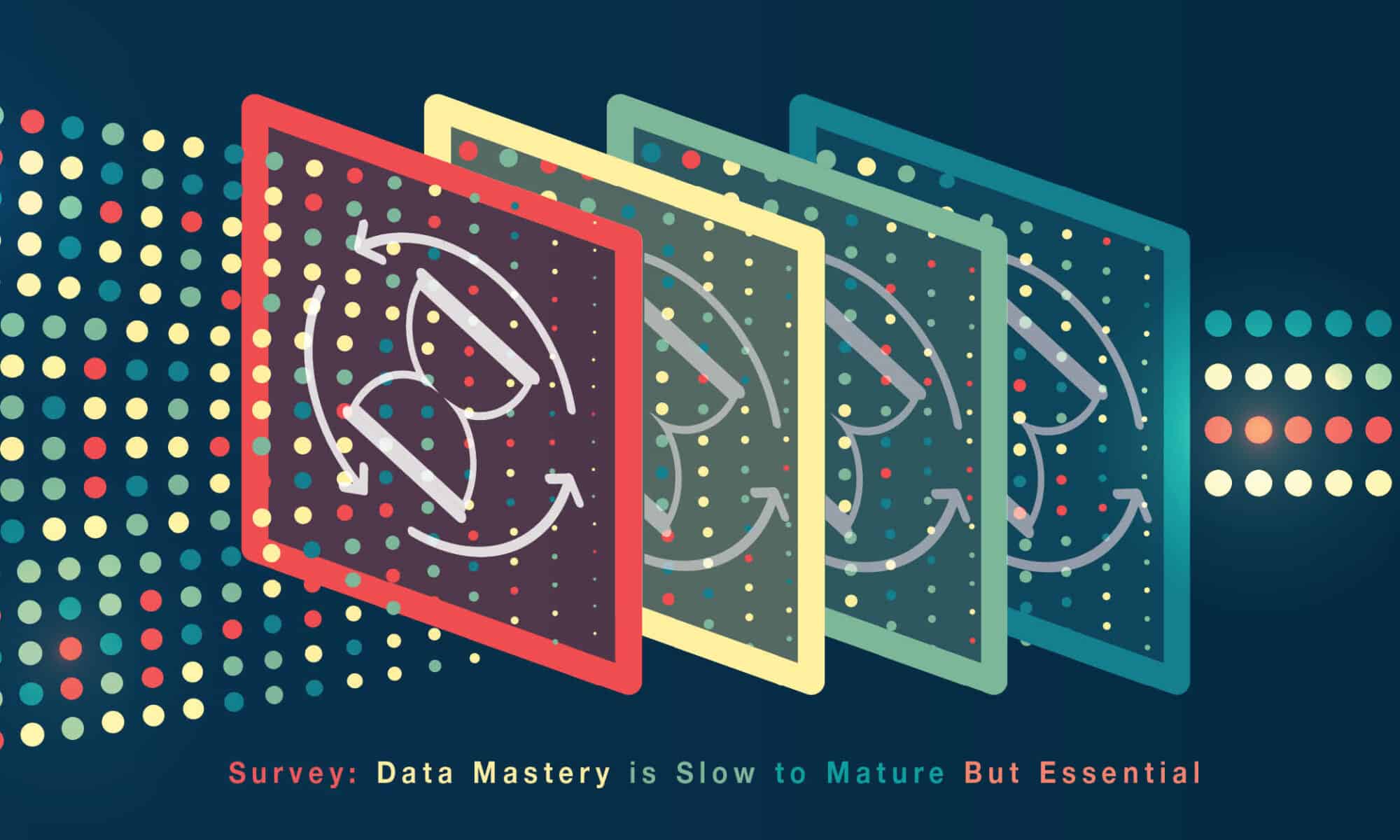
Manufacturers show some progress with data mastery efforts, but much opportunity for growth exists.

When MLC last fielded its Data Mastery survey in 2021, senior content director Penelope Brown wrote of the results, “Manufacturing data mastery is in its tween years for most enterprises – certainly past its infancy, but still awkward and gawky and not quite fully formed.”
If data mastery was a tween then, the effort is on the final stages before becoming a teenager now. Like a tween, there has been some maturation but also some regression in how companies are accessing and using data and analytics. Likewise, companies can see dramatic development in specific areas of data utilization, but each organization seems to mature at its own pace while encountering a wide array of challenges and pursuing various desired outcomes and focus areas.
Why is progress slow? To further the tween metaphor: perhaps it is growing pains. More than one-third of respondents tell us that the volume of data they’re collecting has at least doubled. Nearly 20% say the amount of data has at least tripled. Before this exponential growth came into play, companies were already dealing with an uphill climb to verify and analyze data. Given this rapid growth – like in tween years – there’s bound to be some awkwardness and slower progress.
Still, it is clear from the 2023 MLC Data Mastery and Analytics survey that mastering manufacturing data will be essential to future competitiveness. Presently, 91.1% of respondents report that data has allowed for more accurate or timely decisions, both of which are essential to overcome the pressures that businesses face now and those they will face as their data mastery skills continue to mature.
Read on for key findings and selected graphs from the 2023 Data Mastery and Analytics survey.
Part 1: Data Strategy and Governance
The majority of respondents have a formal data plan and guidelines in place, but there has been little change since the last time we fielded this survey in 2021. Currently, 56.5% of respondents say they have a corporate-wide plan, strategy, or formal guidelines for how data is collected and organized. This number sat at 55% in 2021.
Q: Does your company have a corporate-wide plan, strategy, or formal guidelines for how data is collected and organized across the enterprise, including manufacturing operations? (select one)

For those with a formal corporate-wide data strategy, nearly all (90.5%) see at least some alignment to overall business strategy, but only 52.4% say it aligns entirely or very closely.
Q: If your company has a corporate-wide plan, strategy, or formal guideline for how data is collected and organized, how closely do you feel this data strategy is aligned to your company’s overall business strategy? (select one)

Measuring data’s value is still elusive to many organizations. However, there’s been increases in assigning monetary value and measuring revenues of data-driven services in the past two years. In fact, 22.6% of respondents now say they measure the value of data in monetary terms compared to 4% in 2021. Meanwhile, 12.1% say they measure data’s value by revenues of data-driven services compared to 3% in 2021.
Q: How do you measure the value of the data in your organization? (select all that apply)

Manufacturers see a slight positive shift in their ability to collect the right data the business needs. In 2021, 16% of survey respondents ranked their company as highly able to collect the right data. In the latest survey, that number has climbed over 20%. On the low end of the spectrum there was only minimal change moving from 26% in 2021 to 26.8% in 2023.
Q: How would you rank your company’s ability to collect the right data the business needs from your manufacturing operations? (select one)

Part 2: Data Collection, Use, and Analysis
The ability to analyze manufacturing operations data is an opportunity for growth. Just over half of respondents report their company is moderately able to analyze the data, while 30.4% say they have low competency.
Q: How would you rank your company’s ability to analyze the data from your manufacturing operations? (select one)

Shop floor systems and ERPs remain the primary data sources. In fact, shop floor systems use increased from 79% in 2021 to 88.4% in 2023, while ERP systems increased from 77% in 2021 to 83.9% in 2023. Quality control systems, equipment maintenance systems, supply chain systems, and robotics systems saw similar increases since the previous survey, but product development systems fell 16 percentage points to 22.3%.
Q: What are the primary systems that generate your manufacturing data today? (select all that apply)

The survey revealed that there is considerable room for growth in real-time data collection. Less than half of respondents report their company’s data is comprised of 51% or more real-time or near real time data.
Q: What proportion of the data you collect today is real-time or near real time, not batch or historical? (select one)

In the past two years, companies are collecting more manufacturing data. Eighty percent report they’ve seen at least some increase in the amount of data collected. Meanwhile, more than one-third of respondents say the amount of data has at least doubled in that time.
Q: What has been the percentage increase in the amount of manufacturing data you are now collecting compared to two years ago? (select one)

Looking ahead at the operational focus for data projects in two years, respondents foresee a varying shift from manufacture, quality, maintenance, inventory, logistics, and assembly to process control, supply chain, track and trace, inspection, security/data protection, and tooling.
Q: What are your primary areas of operational focus for data projects today and what do you expect the primary focus will be in 2 years’ time? (select top three)

Microsoft Excel remains the reigning champion of data analysis tools. In 2021, 71% of survey respondents reported that Excel was in their data analysis toolkit. That number rose slightly in 2023 to 72.3%. Statistical analysis programs of standard BI systems jumped from 47% in 2021 to 60.7% in 2023. This moved it from the fourth most used tool in 2021 to second place this year. Meanwhile, manufacturers are increasingly outsourcing analytics, with 24.1% utilizing external analytics partners this year compared to 14% in 2021. Somewhat surprising, the use of AI systems has decreased from 48% (when taking in-house, cloud and external AI partners in aggregate) to 41% in 2023.
Q: What systems do you use to analyze the manufacturing data you collect? (select all that apply)

Respondents’ companies are evenly split when asked about verifying the accuracy and quality of raw data. About 46% report they have a process while approximately 45% say they do not. In the 2021 survey, for comparison, 49% reported they had a process while 46% reported they did not.
Q: Does your company have a process to verify the accuracy and/or quality of the raw data before decisions are made on it? (select one)

Part 3: Outcomes and Challenges
Increased data access has resulted in a variety of operational improvements. Leading the charge are cost reductions, productivity improvements, efficiency, quality, and uptime – all of which were cited as an improvement seen by 50% or more of survey respondents.
Q: In what ways has increased access to manufacturing data helped you to improve your manufacturing operations? (select all that apply)

Cost reductions are the primary motivator for new manufacturing data projects now, and this is expected to remain constant in two years. In fact, 65% of 2021 survey respondents anticipated that reduced costs would be a key business outcome objective this time around – a number that tracks closely with the 67.6% that listed reduced costs on this year’s survey. While reduce costs is anticipated to lead the charge again in 2025, the number is anticipated to decrease by 10 percentage points in that time. The biggest upward movers by 2025 are expected to be improved production speed, integrated processes, improved supplier network effectiveness, improved security, and monetizing data.
Q: What are your key business outcome objectives for embarking on new manufacturing data projects today and what do you expect the outcome objectives will be in 2 years’ time? (select top three)

Data improves accuracy and speed of decisions. Half report that decisions have been more accurate and 40% point to more timely decisions. Only 6.3% of respondents report that there has been no change in their company’s decision-making because of data availability, while less than 2% of respondents, respectively, cite slower or worse decisions as the most prevalent way that data has affected their decisions.
Q: What is the most prevalent way that data has affected your company’s decision-making? (select one)
Survey respondents report that many challenges or obstacles are hindering their company from making more data-driven decisions. The leading challenges – each cited by 39-49% of respondents – are extracting data from legacy systems, lack of skills to analyze data effectively, and integration of data from different sources.
Q: What are the most important challenges or obstacles hindering your organization from making more data-driven decisions? (select top three)

Three out of four respondents report that data mastery is essential to their business competitiveness in the future. This 75%/25% split remains consistent with responses to the 2021 survey.
Q: Looking forward, how important will mastering manufacturing data become to your competitiveness as a future business? (select one)

About the author:

Jeff Puma is Content Director for the Manufacturing Leadership Council
Survey development was led by the MLC editorial team with input from the MLC’s Board of Governors.
Dialogue: Developing Pella’s Data Driven Culture

Creating a culture where all employees understand the importance of data to driving operational improvements and value is crucial to the future of manufacturing, believes Pella’s Head of Advanced Analytics, Jacey Heuer.

“What drives me is being part of that blank canvas and having the opportunity to create something with data analytics that is so game changing not only to Pella, but to the whole industry.”
Jacey Heuer, Head of Data Science and Advanced Analytics, Pella Corporation
Pella Corporation was founded in 1925 when lumber business owners Peter Kuyper and his wife Lucille acquired a small manufacturer of roll-up insect screens called the Rolscreen Company and moved the business to Pella, Iowa. As Pella approaches its centenary in 2025, the company has now grown into an award-winning $2 billion enterprise, with 10,000 employees, 17 manufacturing plants across the U.S., and one of the largest window and doors manufacturers in the U.S.
In our latest interview with an industry thought-leader, Pella Corporation’s Head of Data Science and Advanced Analytics, Jacey Heuer, talks to the MLC’s Executive Editor Paul Tate about transforming a mature corporation in the digital age, the need to build a solid data foundation to help reimagine traditional processes, harnessing data analytics and AI technologies to create new insights, and creating a culture of ownership where every employee understands the true value of data to improving the future of the organization.
Q: What excites you most about your role at Pella?
A: It’s the nascent nature of data and analytics in the manufacturing industry, especially in advanced data science and machine learning AI environments. Historically, there have been data and statistics and optimization initiatives in many different forms, like Six Sigma, Lean, and traditional business intelligence systems, which have been around for decades. That’s the precursor to what we’re trying to create now with the next generation of data driven solutions.
My focus is on how we accelerate to that next level of leveraging our data at Pella to drive greater economic value and greater impact across the enterprise – from customer experience and marketing, to improving the P&L and optimizing throughput capacity in manufacturing operations.

“The challenge is how do we tear the traditional processes down to introduce a new data solution that drives improvement? That’s the greatest part in all this. It’s re-imagining the way things are done.”
A lot of this stems from how we collect data. In the past, there’s been almost a taboo around adding individual transactions to data resources. Traditionally we’ve tried to eliminate that transactional data to create more efficiencies and productivity. Yet, all those transactions are data rich sources of what’s really happening as materials or products go through a facility.
This is one area where my team is now helping to change that perspective because, in a data-driven world, those transactions are valuable to us to help us continue to develop greater optimization, more insights from AI and machine learning, and better outcomes. What drives me is being part of that blank canvas and having the opportunity to create something with data analytics that is so game changing not only to Pella, but to the whole industry. There’s a lot of excitement and opportunity in that.
Q: How are Pella’s data analytics and data governance activities structured within the organization?
A: The corporate Data Analytics and Insights team, which I help to lead, is around 14 people right now and it spans core roles in data science, data analytics, data engineering, data governance, and data quality.
Our vision is a hybrid model where each plant still owns some of their data and analytics, but we at least have a governance role or advisory role in how those plants and different facilities are leveraging and using that data. I fact, we prefer to use the term data enablement, as opposed to governance, because it has a more positive connotation.
We’ve also established a corporate Data Council, and a layer of data stewards who are the front-line owners of data analytics in different facilities and are our main conduit to make sure that we’re developing and rolling out solutions in an effective manner.
The Data Council meets on a quarterly basis and includes directors and senior level leaders who provide executive sponsorship and buy-in, oversight, guidance around prioritization and what’s most important, and help steer how we drive forward. These leaders act as a megaphone for us and go down into their functions to help drive the change in mindset around data generation and use.
Further down, we also have the layer of data stewards. These are people on the frontline who may have developed a legacy system, or are in our continuous improvement environment, or in our engineering space, and are the true data owners who interact with data day-to-day. We have a roster of these data stewards, and we meet with them on a monthly basis to continue to develop a culture of data ownership and an understanding around the importance that data needs to play as move to the next generation for Pella as a data driven organization.
Q: What are the main data analytics initiatives now underway at Pella?
A: There are two key initiatives, both targeted ultimately on improving the customer experience. The first is a smart factory initiative. We have two plants that are developing different elements of a smart factory. One plant is focused more on automation, so autonomous vehicles, robotics, and those kinds of technologies. The other plant is focused more on process optimization. There’s a lot of cross-over between those, but that’s they’re starting focus.
The other key initiative is reliable delivery. We have a goal of “industry best” reliable delivery at Pella. So, we are working on how we ensure on time delivery by fully leveraging the data and applying predictive modelling using AI and machine learning technologies.

“If you don’t have a focused diligent investment into the type and frequency of the data you’re collecting, your AI and machine learning outputs are likely to struggle and perhaps fail.”
Within both of those initiatives is a focus on people, understanding individual capabilities and skills so we can optimize the role they are working on in the factory and make sure they are placed in the best position to help drive optimization.
Q: How are you integrating the data generated by legacy systems into the new analytics framework?
A: Legacy systems historically tend to be production databases where the data only exists for a short length of time before it’s purged out. We’re now applying more event-driven monitoring technologies where we can monitor each system in more detail and anytime a new event occurs, we’re taking that data out and moving it into our data lake environments to create a history of all the data. We’ve introduced technologies using application interface layers (API) that essentially provide one entry point for all those legacy systems. This helps us gain greater access to the legacy systems and move the data more easily to locations where data scientists can then work with it, or machine learning can happen, which is mostly in our cloud environment.
On top of that, from a front-end consumption standpoint, we’re developing our own internal applications so we can take the output of our AI data science models and feed it into those applications where we have more control over the user interface and experience for the people who need the information. That helps bridge that gap from the legacy to the modern, and helps develop the people, the resources, and the skills we need to make the transition occur.
Q: Once you’ve gathered all this data and analyzed it to give you new insights, how do you then operationalize those insights to drive better decisions?
A: That’s a great question. This is where the network of data stewards and the data council becomes crucial. Ultimately, they’re the people who are helping us connect with the users on the shop floor, the line managers, and the production managers, who are going to be consuming these outputs. And it’s also about how we deliver that information to the users. Think about your phone, or Facebook, or Google. There’s a whole team of individuals focused on your user experience. Historically, when you are getting a model or AI solution into production, a lot of its downfall can be because of the user experience. It can make a cool prediction, but as a user, it’s not always intuitive to use. Or there’s other reasons that might limit a person’s willingness to adopt it. We’re now leaning into that aspect of how we actively engage with our users to make sure we’re creating the right user experience so that our outputs are meeting that need. That’s helping to drive a lot of consumption and adoption.
Q: How are you harnessing AI technologies to help drive this data-driven transformation?
A: AI and machine learning are fueled by data. Like a car, or a tractor, or any big piece of machinery, it’s the fuel that makes it productive. It’s the same with AI. That data foundation is where a lot of our focus has been initially and on how we continue to influence the type of data we’re creating. I mentioned event driven technology solutions, for example. That stream of event data coming in means that we’ve now got much more clarity from when an order enters our system, to every event along its journey, to when it exits. We can see the timing and the context around that journey. We’re now able to build predictive models that are much more accurate on when an order reaches different milestones to ensure it can be delivered on time and in full to the customer. That’s an area that we’ve had a big initial impact in building predictive models that drive scheduling and the decision points along the way. On the smart factory side, for example, we’ve got a big focus on process optimization. There can be somewhere between 1,000 and 5,000 carts moving around our door facility at any time, which is where our automation focus on smart factory is happening. We’ve now applied RFID tags to the carts so we can collect passive signals as they move through the facility. We’re then leveraging that data to improve route optimization within our plants because we are able to establish see a clear linkage between the impact of delays at certain points in that process to lost units created that day. There’s clear value in that use case. The next stage is to understand how we can best scale that across our 17 plants.

“One of the key leadership skills for the future is greater trust in the individuality of all the team members, all the workforce and allowing them the freedom to create, to think, and to make decisions.”
It’s that kind of data foundation that’s going to fuel many more AI use cases for us as we go forward. Of course, understanding the intrinsic value of having a strong data foundation is something that’s not always intuitive for everyone to grasp. That’s an area where our storytelling has continued to evolve for our leadership and our plants about why investment in those technologies is going to serve us in the long-term. If you don’t have a focused diligent investment into the type and frequency of the data you’re collecting, your AI and machine learning outputs are likely to struggle and perhaps fail.
Q: What key challenges still keep you awake at night?
A: One of the core challenges is cultural. We’re trying to change the mentality so that everyone in the company has a greater understanding that every point of data, every action that someone on the shop floor or in manufacturing takes, either does, or will eventually, generate some data point that’s going to be crucial input to helping improve their lives, improve the P&L, and improve our impact as an organization as we go forward.
Another challenge, but a good challenge, is how we solve some of the technical aspects of creating a data-driven organization and re-imagine the processes that currently exist. We can develop models, develop solutions, push them to the five-yard line and are ready to hit the end zone, but then we come up against a wall of the way things have always been done. People say, “Well, this is the process”. The challenge is how do we tear that traditional process down to introduce a new data solution that drives improvement? That’s the greatest part in all this. It’s re-imagining the way things are done. In a hundred-year-old organization with a hundred years of legacy and processes in place, that’s what keeps me up at night in many ways.

“Eventually, anybody who interacts in the organization and takes an action will be able to understand how it impacts the bigger network of what’s happening.”
Q: Looking ahead, what would you highlight as the greatest challenges and opportunities for manufacturing industry as a whole for the rest of the decade?
A: I think there’s a great opportunity to create a truly connected network of data within a manufacturing organization, so that if a decision is made on one side of the business, people can see the impact that decision has way over on the other side. Eventually, anybody who interacts in the organization and takes an action will be able to understand how it impacts the bigger network of what’s happening. For example, if I make a decision to reorganize some physical part of a plant, I can see the expected impact on the other plants that are outside my immediate location. It’s a connected network of understanding, supported by a focus on the data foundation and driven by investments and front-line engagement in creating that data foundation.
Q: What key leadership skills, attributes, and roles do you feel that senior industry executives now need to lead successfully in an increasingly data-driven world?
A: One of the key leadership skills for the future is greater trust in the individuality of all the team members, all the workforce and allowing them the freedom to create, to think, and to make decisions. As people get more transparency and more understanding of the connectedness of every decision they are making, their knowledge of the true scale of impact is going to increase, so they should be able to make better informed decisions and take better informed actions. In an established legacy organization, it’s a different mindset to allow individuals that freedom and capability. From a leadership standpoint, it’s about being okay with that flexibility and that freedom.
Q: Finally, if you had to focus on one thing as a watchword or catchphrase for the future of manufacturing, what would that be?
A: It’s intelligence augmentation. I like that term because I think it captures, in those two words, the role that artificial intelligence and machine learning and data should play, and will play, in organizations in the future. It also highlights that humanity, people, are not going to go away, and that we need to ensure there’s teamwork between those people and the new technologies that will come our way. Intelligence augmentation captures that well. M

FACT FILE: Pella Corporation
HQ: Pella, Iowa
Industry Sector: Windows and Doors
Revenues: $2.17 billion
Net Income: (Privately held)
Employees: 10,000+ Employees
Presence: USA
Production Sites: 17+ Manufacturing Sites
Website: www.pella.com
EXECUTIV PROFILE: Jacey Heuer
Title: Head of Data Science and Advanced Analytics, Pella Corporation
Nationality: American
Education: BA degree, Business Administration – Finance & Economics, Wartburg College; Masters’ degree, Business Analytics and Data Analytics, Iowa State University; MBA, Iowa State University
Languages: English
Previous Roles Include:
– Data Scientist, Pella Corporation
– Data Science Author, Pluralsight
– Data Scientist, Brownells, Inc.
– Senior Pricing Strategist, MidAmercian Energy
– Assistant Vice President, Situs RERC
– Financial Analyst, The Members Group
Other Industry Roles/Awards/Board Memberships
– Golden Key International Honour Society, Iowa State University
– Iowa Technology Leadership Institute member
About the authors:

Paul Tate is Co-founding Executive Editor and Senior Content Director of the NAM’s Manufacturing Leadership Council.
Case Study: The Future Starts with Citizen Data Scientists

How IBM is developing the next generation of transformation-drivers by turning supply chain SMEs into Citizen Data Scientists

Company Fact File
Name: IBM Corporation
Sector: Information Technology and Services
HQ location: Armonk, NY
Revenues: $10 billion plus
Employees: 5,000 plus Employees
Web url: www.ibm.com

When COVID-19 hit, IBM Supply Chain found that its digital transformation journey had enabled the resiliency needed to tackle major disruptions. That awareness led to the decision to further accelerate their digital transformation projects. To keep up with the demand of exploiting emerging technology while preparing for future, IBM launched a first-of-a-kind transformational upskilling initiative designed to democratize data while empowering individual business technologist (SMEs). This transformative initiative is a prime example of the mantra Ron Castro, IBM Vice President and Chief Supply Chain Officer, constantly challenges his organization with “innovate anywhere, use everywhere.”
The initiative, dubbed the Citizen Data Scientist (CDS) Certification program, was designed to help supply chain SMEs develop the data science skills they need to make data-driven decisions in a fluid business environment — and then roll it out to the rest of the company to engage employees in successful process improvement throughout every part of the organization.
In just the first year, the CDS program developed by IBM Supply Chain, in partnership with the IBM Data Scientist Profession Team, the company already was seeing results. The first supply chain SME cohorts to go through the program’s data science, data wrangling, and data visualization upskilling and reskilling structured learning program resulted in more than $1.6M in efficiency and productivity improvements and inventory savings from improved decision-making.
All this in just six months, and with zero financial investment. And the program has only continued to grow ever since in both the breadth of its content and its reach across the company.
What Is a Citizen Data Scientist?
As manufacturing moves into M4.0, the role of big data is only getting bigger — and more ubiquitous throughout operations. Data scientists, who usually have a master’s or PhD, are essential. However, there may not be enough of them to go around, and even if there are, their level of business expertise may not be sufficient in a specific domain.
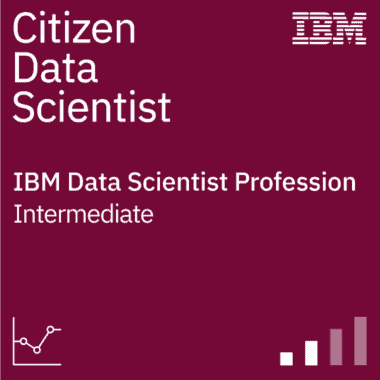
Hence the rise of the Citizen Data Scientist. According to Gartner, a citizen data scientist is “a person who creates or generates models that leverage predictive or prescriptive analytics, but whose primary job function is outside of the field of statistics and analytics. They bridge the gap between those doing self-service analytics as business users and those doing advanced analytics as data scientists.”
IBM’s Citizen Data Scientist digital credential is designed to create more of these data-savvy employees so they can bring the power of data analytics to aspects of their daily jobs without having to rely on those who call data science their profession. At IBM, the CDS certification also is integrated into the company’s career path, so it serves as a starting point for those who might be interested in becoming a full-fledged data scientist.
Starting with an Innovation Foundation
The CDS certification program was established on a foundation of innovation that would encourage continuous transformation. One bedrock of this foundation was to reimagine and transform people’s analytical skills using IBM and open-source technology to retain and create a high-performing, engaged culture. Another was to leverage the reskilled SMEs to reimagine processes, then apply AI and Cloud technologies to implement new processes to accelerate transformation.

“The CDS certification program was established on a foundation of innovation that would encourage continuous transformation.”
“We wanted to certify people who could really work on data to bring our broader population into IBM’s digital transformation,” says Matthias Graefe, IBM’s Director of Supply Chain Transformation. But it isn’t enough to just offer one-off classes in, for example, Python programming, which would likely result in the creation of isolated applications and solutions. The company also wanted to ensure that its latest crop of Citizen Data Scientists has an understanding of cybersecurity, because a talent in programming doesn’t automatically mean the person understands how to ensure the programming, they’re creating is also compliant, Graefe says. “We knew we wanted to achieve both sides of it — enabling people in a supportive way, while also creating a community and governance around what they are doing.”
Taking the CDS Challenge
Brenda Berg, CDS Program Manager, advises that the CDS program requires more than just watching some videos and taking a test to earn the digital credentials. It may not be as difficult as becoming a full-fledged data scientist, but the Citizens Data Scientist certification still is no walk in the park. In fact, only 70% of the first year’s CDS trainees made it through the program. The nature of the learning, uninterrupted time commitment and demanding day jobs are what makes the program challenging.
To help keep candidates on the learning path, the program is highly structured and includes having a technical leader, a program manager, and a project manager agree to facilitate the process. Each candidate also is assigned a mentor to help them develop the data scientist mindset and build the new ecosystem together with professional data scientists. Employees who chose to participate could leverage their allocated IBM global training program learning hours to gain data science knowledge and skills.
CDS candidates initially were chosen by their managers because it takes a true commitment on both the participant and their managers, says Giovanna Benetti, Digital Supply Chain Transformation Leader. The self-paced training is done in parallel with participants’ day-to-day jobs, so both their managers and the participants need to ensure that they can complete the program while still getting their daily work done.
The data science mentor role also is a key one, she adds. They meet regularly with CDS participants to assist with coursework understanding, application, and provide guidance on the required Citizen Data Scientist project plan to complete the certification. Now that the program has an established, and growing, bank of certified Citizen Data Scientists, the idea is that some of those who have been through the program can now turn around and assist new trainees within the CDS community. Or, as Anita Toth, Global Supply Chain Manufacturing Operations and Integration Manager, says, “We now have started to eat our own cooking. The people who have graduated from the CDS program are now applying their skills back to the business, either vertically in their own domain or cross-organizationally. We have some Citizen Data Scientists who just graduated one year ago who now are guiding people who are currently in the program.”

“A key component to the program is that participants also must apply what they are learning to real-world projects.”
Another key component to the program is that participants also must apply what they are learning to real-world projects. These projects generally fall into three buckets. One is what IBM calls “big rocks,” which are multidomain, large-scale projects that are important to the organization overall. “It’s a benefit for employees to work on these big rocks projects, because they can both experience different functional areas, and are able to contribute on projects that have a big impact,” says Graefe. Then there are smaller projects, or “pebbles,” which generally fall within a specific business or functional area, and even smaller, more specific “sand” projects. Of course, the big rocks projects result in the most material savings — and the highest visibility. As an example, a 2020 CDS participant’s pebble project resulted in a $50K inventory savings for his business unit. After CDS graduation, he partnered with CDS multidomain colleagues to drive a services and manufacturing synergy project. Over the past two years this advanced deep learning-machine learning model contributed over $10 million in inventory savings and cost reductions.
The key to successfully completing the program is for the candidate to have the support of their manager or supervisor, and their entire team. Erin Thalacker, CDS Project Manager, also advises it’s vital to connect early and often with their data science mentors so everyone understands what business problem they’re trying to solve through data science, and also make sure they have access to data and that they understand that data, as well as for help navigating any roadblocks they may hit along the way.
The program still is tough, but those who make it through feel more prepared to be the technologists IBM will need for a future in which automation and data analysis will continue to be increasingly key for most job roles. Having a mentor also is a big boost for many who go through the program, as is having a community of fellow Citizen Data Scientists who not only understand what they are doing, but also can share solutions to common challenges across functionalities. Another perk? Added visibility. “We have a strong sense of community across Supply Chain, and to be able to make an impact in that community is a strong driver within the program,” says Graefe.
Scaling Up
As important as it was to quickly reinvent the supply chain, the program also was designed to be scalable throughout the company by basing the CDS on data science methodology, tools and data trainings that were domain-agnostic. This means that the program can be replicated for any other part of the organization that wants to jump-start its transformation journey with reskilled, resilient, Citizen Data Scientist SMEs.
This is already starting to happen. The original Citizen Data Scientist certification program has been leveraged to pilot additional Citizen Process Designer, Citizen Automator, Citizen Front End and Backend Developer programs.
There was a strong use case already built-in for expanding the program, says Graefe. For example, as IBM continues its drive toward automation, there is a need to create more bots. But those bots need to be programmed so that they add to the greater good — otherwise, they could just create chaos. Also, he says, there was a need to use a common platform and tool set so people can share successful components as they scale up the automation. “If we want to eliminate, simplify and automate, and to drive automation everywhere into our workflows, we need to expand the Citizens program,” he adds.

“The program was designed to be scalable throughout the company by basing the CDS on data science methodology, tools and data trainings that were domain-agnostic.”
“If you need to develop an application, you need people who understand the business requirement, can write the code, and you also need people who can design the UI for the application on the front end. Then you have the automators on the back end. Also, now it’s not just about developing code; it’s about working on platforms, often with low-code applications — you often don’t need deep coding skills now. We wanted to bring all of them under one Citizens umbrella.”
Next up is a pilot program with another business unit that works closely with Supply Chain to see if they can “lift and shift” to make the CDS program work for their specific needs. The team also is close to implementing an overall system to manage the projects the prospective Citizen Data Scientists will be working on so innovations can be shared on platforms with communities who could link those innovations to other areas.
“Our next step is to scale up the CDS to Innovation Technology and get through the pilot, then open it up to the broader IBM community,” says Graefe. “We are creating a community of those who finish their projects and graduate, who then are offered the opportunity to become Citizen Technologists and work across transformation projects to co-create across the supply chain and, hopefully, across IBM in the future.” M
About the author:
Sue Pelletier, a contributing editor with the Manufacturing Leadership Journal, is a seasoned writer/editor with experience in online, social media, e-newsletter, tablet app, book and e-book, and print publications.
The Journey to Analytics Maturity
Manufacturing Leadership Journal content and MLC resources are exclusively available to MLC members. Please sign up for an account or log in to view this content.
M2030 Perspective: More Robots, Better Jobs. But How?
Manufacturing Leadership Journal content and MLC resources are exclusively available to MLC members. Please sign up for an account or log in to view this content.
The Hammer Versus Nails Strategy for Data Analytics
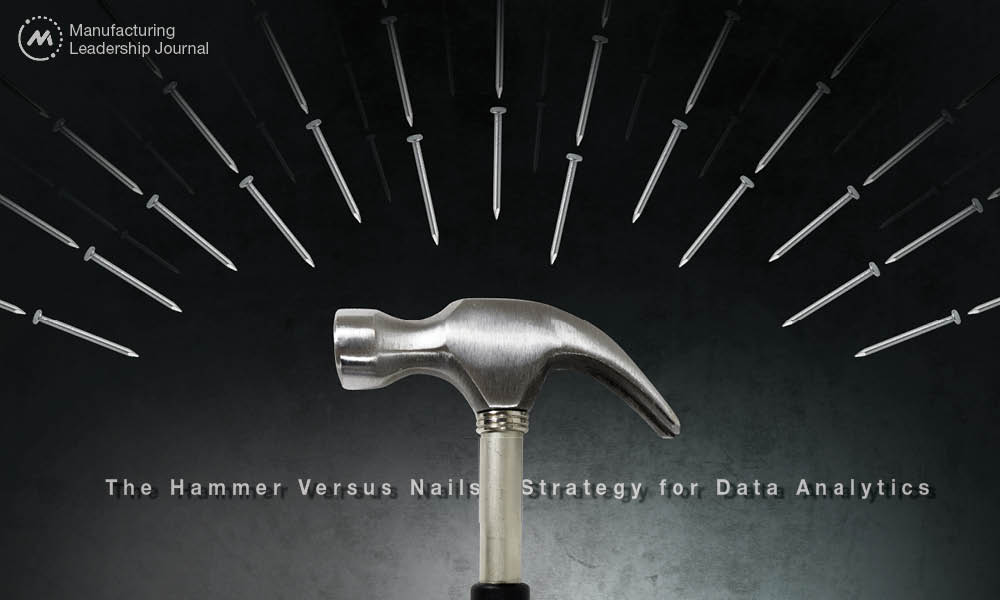
Taking a pragmatic approach to data analytics by focusing on business goals rather than technology allows companies to deliver incremental value.

TAKEAWAYS:
● Many developments in AI/ML for manufacturing can be leveraged now.
● The challenge is driven by people, technology, and process.
● An agile and pragmatic business centric approach can allow for tangible benefits without the high upfront investment.
Manufactures continue to exist in a complex juxtaposition of needing to significantly invest in technology to improve business operations, while still navigating difficult supply chain issues that require keeping costs down and focusing on retaining talent. Given a choice, the natural tendency is to pick the path of known and least resistance. But if the choice requires a difficult decision, sometimes no choice at all is the most likely outcome.
The use of data to drive better and faster business decisions is a necessary component of any executive strategy. Data is the next elixir in the quest to improve operational margins in the same way that cloud infrastructures allowed businesses to grow and transform over the last decade.
The use of machine learning to examine and augment the decision-making process is a similar and exciting extension of data driven decisioning. For example, on the shop floor AI is used to reduce scrap by identifying defective products as well as providing recommended changes to machine and process settings to prevent future issues. AI is also becoming heavily integrated in asset-intensive facilities to analyze sensor data and prevent downtime by alerting operators on potential issues. Beyond asset performance management, companies can also leverage shift and production information to improve workforce planning and management. With all the challenges in supply chains, having visibility into future issues also allows for improved spare parts management of operations.

“It is important to remember that the explosion of data use requires an ever-increasing focus on governance strategies as well as security.”
The benefits of better understanding the business from the prism of data is not constrained to factories alone. Think of how important it is to manage a successful organization by having visibility into cashflow or being able to forecast sales orders and expected product production needs. Beyond the internal business, external customers are also increasingly requesting more transparency into supply chains. The expectation is that product passports will be the next great investment in infrastructure.
The illustration in Fig. 1 highlights the importance of thinking about data analytics across multiple operations as a way to drive the business forward.
Fig. 1: Data Analytics Opportunities in Manufacturing
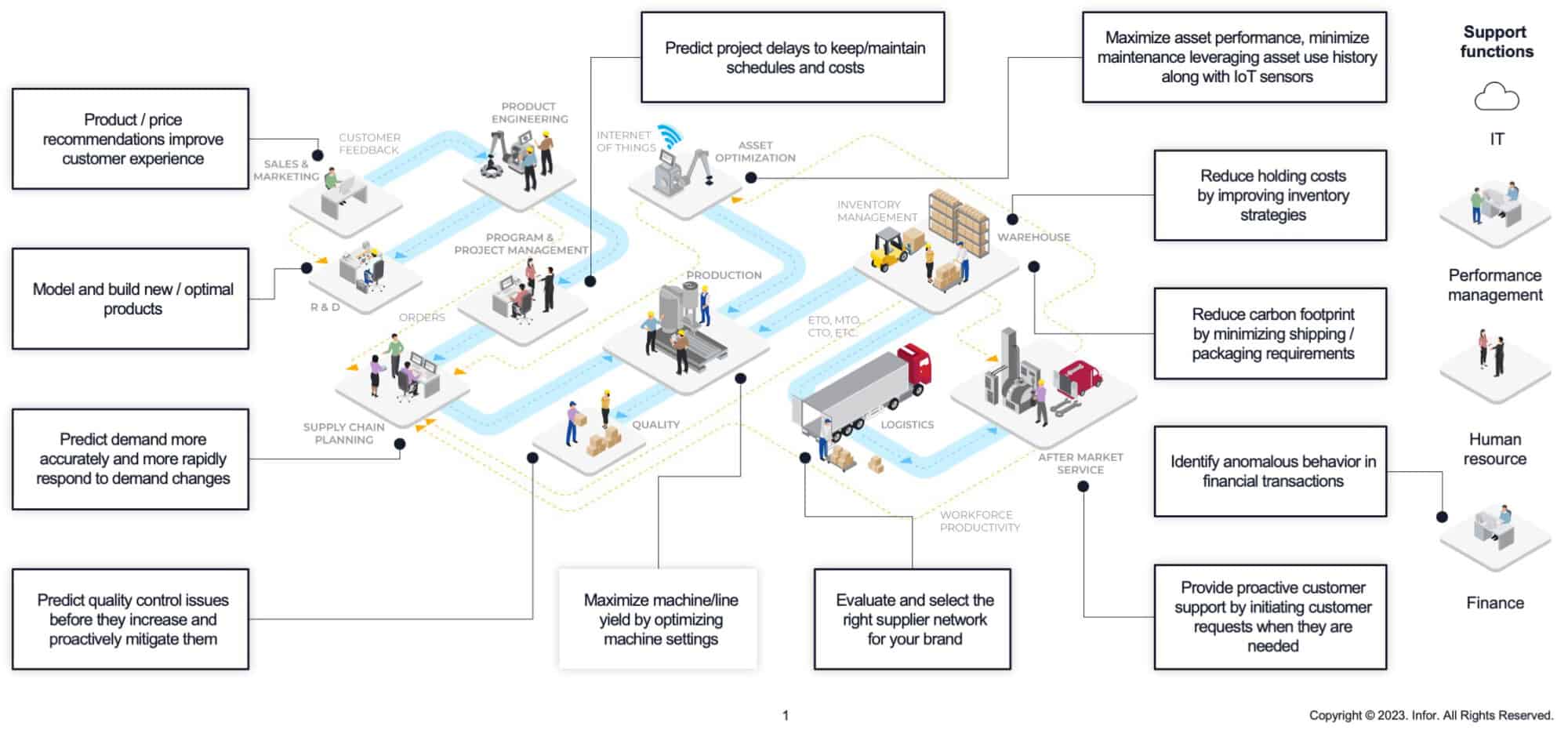
It is important to remember that the explosion of data use requires an ever-increasing focus on governance strategies as well as security. Data needs to be protected and carefully curated for safe and effective business purposes. Most companies have multiple business solutions in a variety of cloud and non-cloud systems and the investment in managing, consolidating, and reporting for those systems will only increase. At any given time, there are also ongoing IT projects to move, change, update, or replace existing systems in many organizations. The impact on business operations can be significant, especially as the workforce must continue learning and adapting to changing technology and business conditions, combined with talent retention challenges as new employees struggle to adjust to old systems.
It is perhaps no surprise that this can be overwhelming combination of factors for manufacturers to cope with.
The Hammer Approach
The best-case scenario is to be able to plan out your business operations as a digital blueprint and track the materials to goods to customer order (and their use) so that you can leverage all the latest innovations to drive quick and proactive decision making.
This is a significant effort and best done in the initial stages of a digital transformation when there are fewer moving pieces. The company can then focus on automating more of its manufacturing systems. Once a company has a digital twin of its key systems, it is easier to make process and technology decisions in harmony with business priorities. Investing in IoT sensors and vision systems to augment your software and infrastructure setup then helps prepare the way for future innovation capabilities.
It is recommended that while building data models companies also consider the different personas who will need access to the systems, their data access rights, as well as what kind of decision or action data needs to be captured to improve the intelligence of the entire business operation.
Other considerations would be around how to manage a data mesh of interconnected systems so there is reduced data duplication and retention. It is certainly more effective to invest in the right analytics when you start from a cleaner slate.
It is easy to get caught up in technology and forget business objectives.

“Once a company has a digital twin of its key systems, it is easier to make process and technology decisions in harmony with business priorities.”
The famous quote by Abraham Maslow: “If the only tool you have is a hammer, you tend to see every problem as a nail,” best describes problems with the hammer approach if you have an over reliance on technology versus solutions.
If the focus on IT infrastructure and software drives strategy and investment, organizations feel the burden of trying to rationalize the investment by looking for very specialized and potentially time consuming and expensive challenges. They end up investing in internet of things (IoT) sensors and storage infrastructure for this information without a clear plan on how to maximize their use. They can also resort to streaming analytic dashboards as way to visualize the information without a clear business driver. There is a great temptation to invest in additional hardware and streaming devices like cameras to leverage the data architecture use. The hammer approach is normally common in organizations that are understaffed or have limited experience with data driving decisions.
The hammer approach is a technology first and only approach to data analytics.
The Nails Decision Strategy
The “nails” are business challenges or goals. All organizations have them and expect them to change as often as needed. Nails are shared focus areas which executives want to move forward as part of a plan to improve their business incrementally.
To be thoughtful and organized is important, and to think of innovation as a “fail forward” approach. Due to the complexity of modern supply chains and plethora of operations systems there is a need to have a top-down executive alignment on an agile business benefit driven transformation plan. Change management is easier if there are quick wins with tangible benefits. Often priorities change faster than the time it takes some IT projects to complete, so it is best to focus on quick time to value.
The six pillars are important guiding principles in employing innovation in manufacturing. Companies can apply them to drive analytic decision making when picking their business goal “nails”.
Fig 2: Six Pillars of Analytics Decision Making
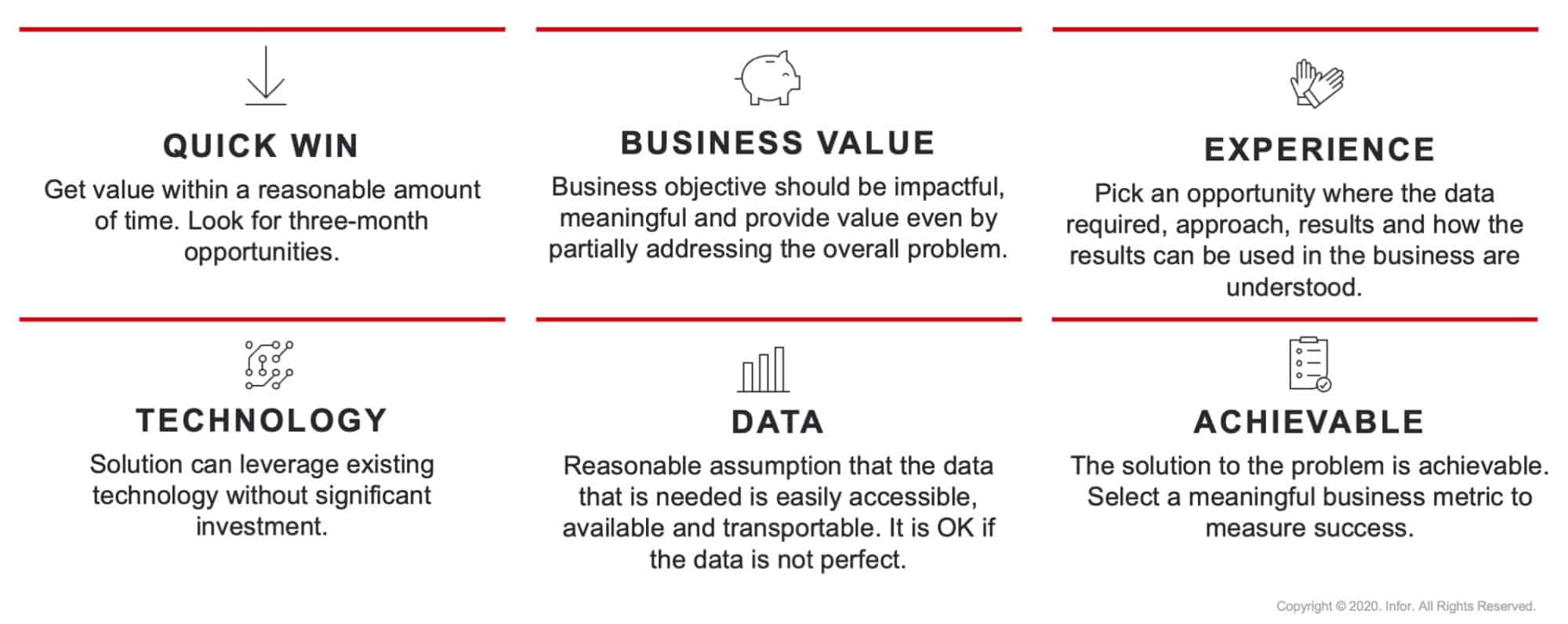
For machine learning driven analytics the availability of data is essential but since it is challenging and almost impossible to get perfect or complete data, the best approach is to reverse engineer the goals to be based on pragmatic business outcomes. A successful approach is to compartmentalize the type of data used in decision making. Evaluate and identify useful data that drives expected business outcomes versus where it does not, and then leverage it where it applies, versus a big bang approach.
While manufacturers have invested in sensors to track equipment performance, there are also pragmatic models that can use asset maintenance history to improve insights into maintenance scheduling versus simple time-based maintenance plans. Applying gradual data enrichment processes allows companies to gently bring in new and additional information where there is sufficient business benefit.
Engaging experienced plant supervisors and operators in leveraging any analytics so there is a way to improve work automation and process is an important tenant in maximizing the use of these tools.
A Pragmatic Approach
With this challenging environment most companies rightfully hesitate to invest significantly in changing their mental approach to leveraging data for business decisioning. The approach each business takes will depend on their culture and priorities, but approaching individual challenges and analytics requirements is an easier and faster way to fully realize priorities. The quick wins can engage all the departments of the business in a more collaborative manner and the investment decisions then tend to be less burdensome.
There is a need to prioritize data management strategies to leverage new analytics innovations in manufacturing and supply chains. How companies go about it does not need to overwhelm their focus.
Focusing on concise business goals (nails) and investing in quick wins is a better approach than building a technology first (hammer) solution. M
 About the author:
About the author:
Sandeep Anand is Senior Director of Decision Analytics and Science Platform at Infor. He has over 15 years of experience building and delivering AI/ML solutions. Experience includes solutions around yield/scrap , supply chain improvements and smart asset management strategies. He leads the AI/ML practice at Infor, a leading enterprise cloud solutions provider.
Leaning Into the Future
Manufacturing Leadership Journal content and MLC resources are exclusively available to MLC members. Please sign up for an account or log in to view this content.
The Data Monetization Wave Picks Up Speed
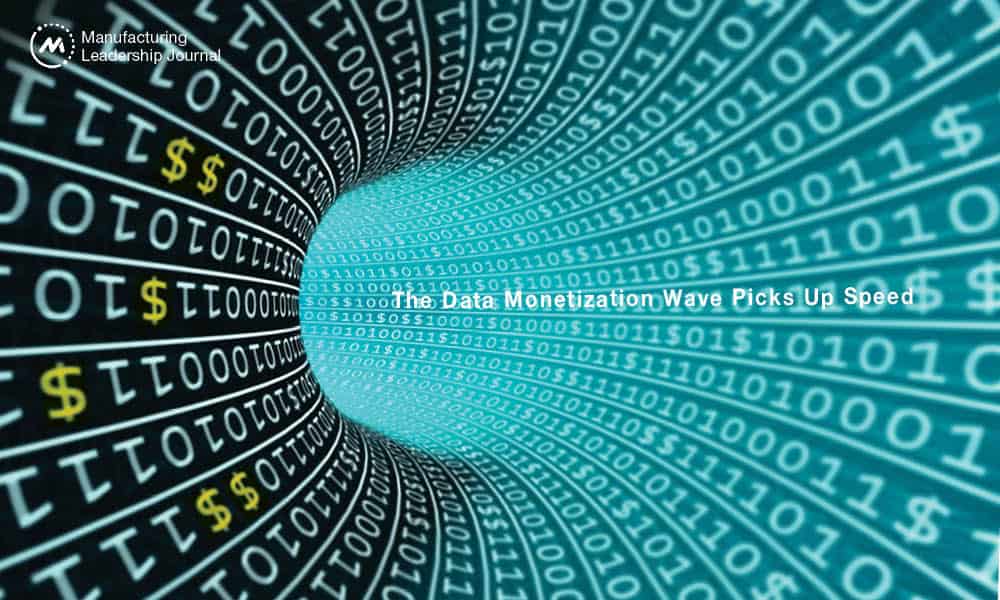
The generative AI tool ChatGPT has raised the competitive stakes, requiring manufacturers to embrace the discipline with greater urgency.

TAKEAWAYS:
● The myths and realities of data monetization.
● A framework for identifying and measuring the potential value of direct and indirect data monetization opportunities.
● How generative AI is a game changer for data analysis, valuation, and monetization.
In the Manufacturing Leadership Council’s recent research, Manufacturing in 2030 Survey: A Lens on the Future, 84% of respondents said they expect the pace of digital transformation to accelerate. That means data—more of it and more opportunity to create value from it.
Extracting value from manufacturing data has been rising up the industry agenda in recent years—fueled by success stories from leaders such as Navistar Internal Corporation, which used to rely on miles traveled or time since the last service appointment to develop vehicle maintenance schedules. By introducing new capabilities to analyze sensor data from 375,000 connected vehicles, Navistar has helped vehicle owners reduce maintenance costs by up to 40%.
The industry’s mushrooming volume of data is reason alone to be thinking about data monetization. Then ChatGPT entered the conversation in late 2022—raising the stakes. With generative AI, a user can now formulate a question and feed it into the model, which queries multiple data sources—potentially even integrated data, such as that from a CMMS system. The output provides an explanation of what the problem could be, the tools/parts needed, and a step-by-step explanation of how to fix the problem. This saves significant time and costly trial and error, becoming a source of value. The very human nature of the interaction addresses one of the big challenges with which manufacturing has been grappling: how to equip its workforce with skills to use data in a digital world.

“The time when generative AI will be able to fully ingest and use a company’s data as well as what it scrapes from the web isn’t far off.”
Competition among Microsoft, Google, and others will only accelerate generative AI capabilities as well as business interest in using them. We can expect to soon see it embedded in workplace technologies, enterprise resource planning systems, and other business applications. That means it’s not a question of if, but when generative AI will be able to fully ingest and use a company’s own data and what it scrapes from the web. While AI communities are eagerly anticipating this, so should data-rich manufacturers because it significantly increases the potential for turning data into value.
This is, of course, just one facet of data monetization. But it underscores the vast potential and pace at which things are changing. If your organization isn’t yet in the game, it’s time. We’ll cover some basic principles to shape discussions about data monetization and some ideas for jump starting or reenergizing your organization’s efforts.
What Data Monetization Is and Isn’t
There are a lot of myths regarding data monetization. It is important to understand that these are, in fact, misconceptions.
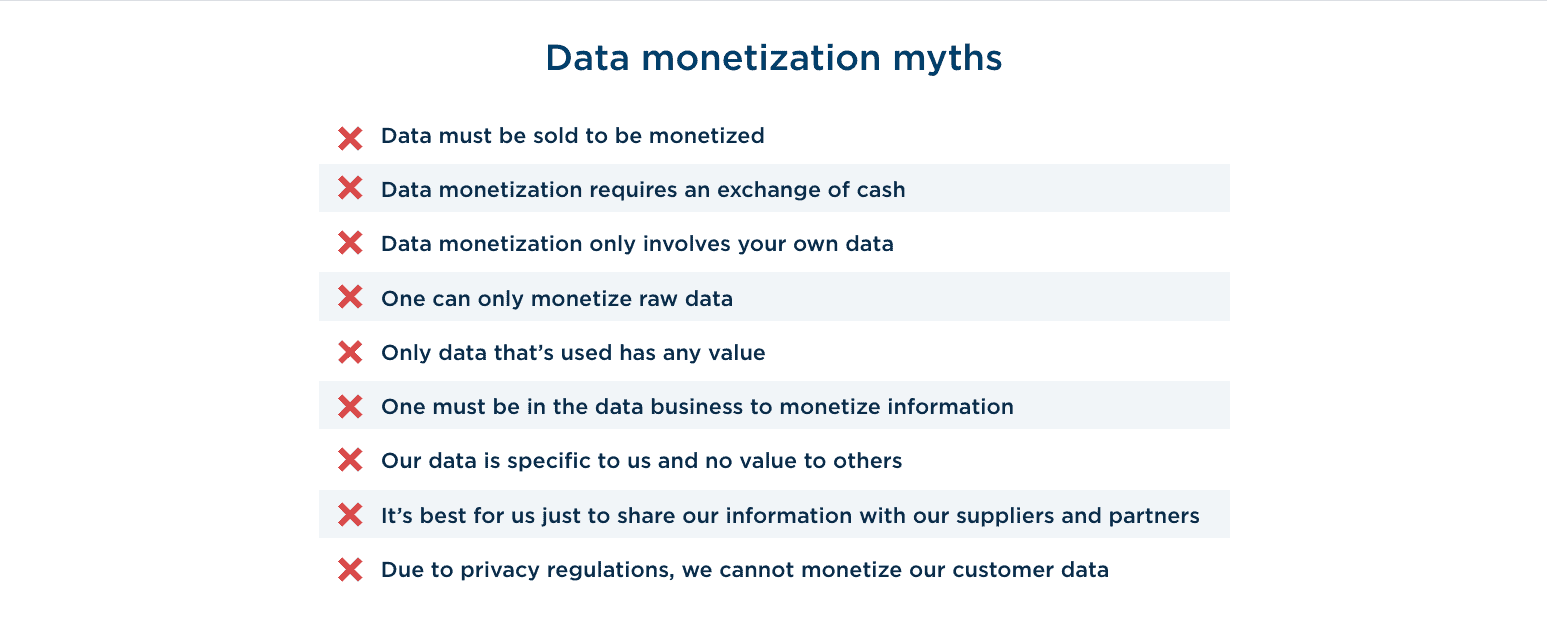
We’ll touch on a few of these, but the first one is key. From our point of view, data monetization is not just about selling data; it’s about using data internally or externally to generate new value streams.
West Monroe defines data monetization as the process of generating new and innovative measurable value streams from available data assets.
There are several key words in that definition. First, data monetization is a process, not a one-time activity. Applying a product mindset—one that focuses on delivering value rather than milestones—is important. A value stream is about generating measurable benefits. If you aren’t connecting the dots from business value to the data used, then you can’t really claim that you’re monetizing the data. Finally, available data assets is not just about the data inside your four walls. It also includes social media data, partner/supplier data, customer data, and open data sources, among others. Data monetization is about harvesting content to enrich and enhance your own data and make it that much more marketable and usable.
Two Types of Data Monetization
We’ve identified about a dozen data monetization patterns. These generally fall into two categories—indirect and direct. Indirect data monetization focuses on internal business processes that generate measurable returns. Direct data monetization involves externalizing data in return for some type of commercial consideration.
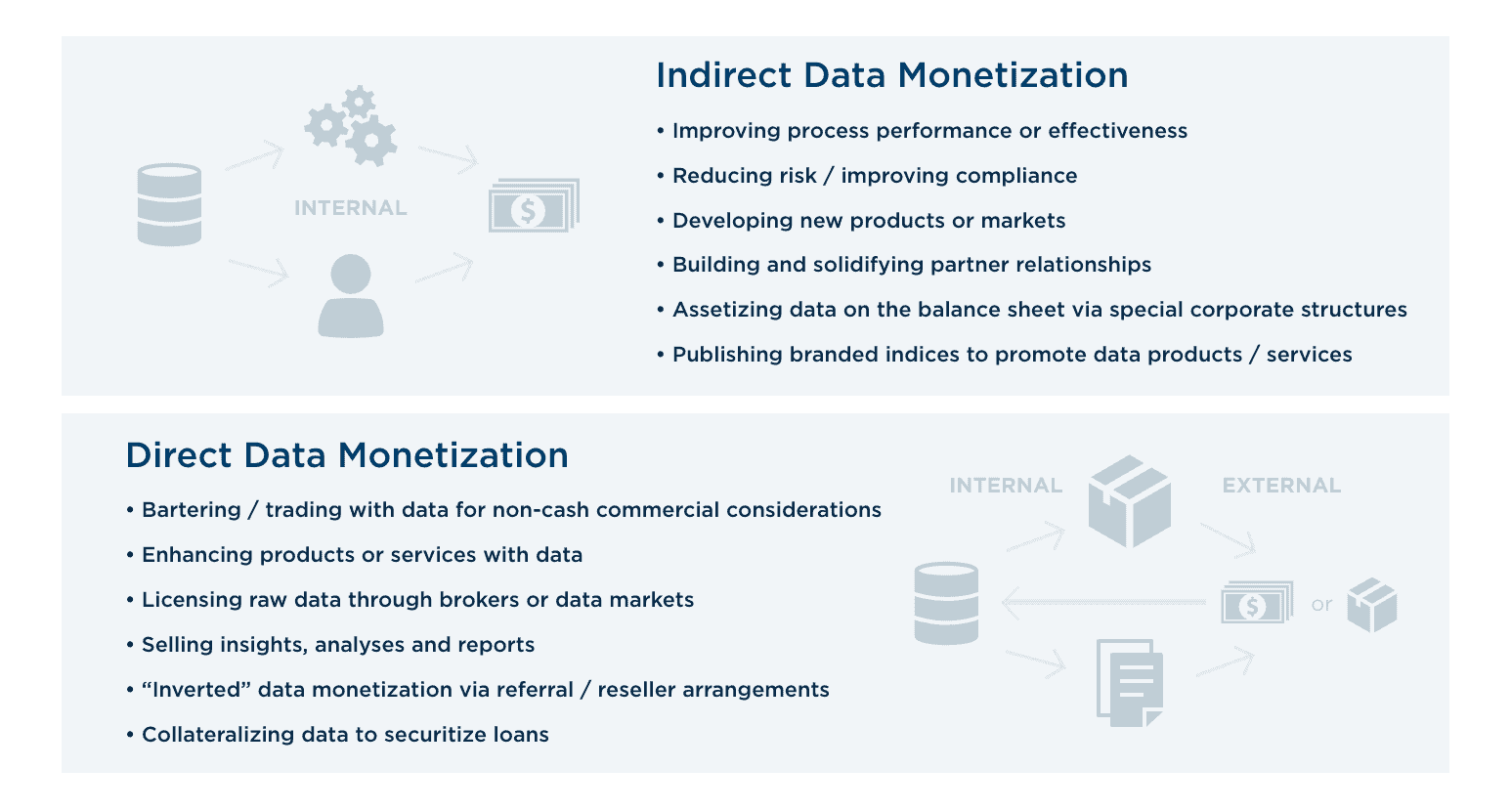
Most manufacturers that have pursued data monetization focus on indirect opportunities. Some have made good progress; for example, with AI/ML models that can predict an outcome (will the machine go down?) or aid decision-making (should we replace or repair?). With new capabilities to analyze data, Harley-Davidson was able to predict machine failures with a very high degree of accuracy, thus reducing unplanned downtime and increasing production capacity 8-10%.
The emergence of generative AI creates bigger and better opportunities for indirect monetization and for direct monetization due to the breadth of data now valuable outside the company. As manufacturers consider new use cases, the need for third-party data will increase, making data (both volume and variety) more valuable on data exchanges.
Naturally, this also raises new questions about data ownership, including who owns the data scraped by the model and whether/how they should be compensated? Consider, for example, the data produced and captured by manufacturing equipment used in a factory: Is that the equipment OEM’s data or the manufacturer’s data?

“Data monetization isn’t just about selling data; it’s about using data internally or externally to generate new value streams.”
In any event, keep in mind that it is not the generative AI model that has value. The value is in the data itself and the productivity of using it more effectively to produce insights, content, or other commercial benefit. And that brings us to packaging.
Just like any product, you can sell raw material in some form. In the case of data, it can be shipped in bulk via FTP or provided through an API. But one of the most common misconceptions is that a company can only monetize raw data. That isn’t the case. Because of its unique aspects, data can be packaged in numerous ways. In fact, data products get more valuable when you travel down the list in the figure below, using data to enrich other data or create analytics or insights or custom data products or even integrate data into suppliers’ or partners’ systems. Just as with other raw materials, the more you process data, the more expensive and exclusive—and valuable—it becomes.
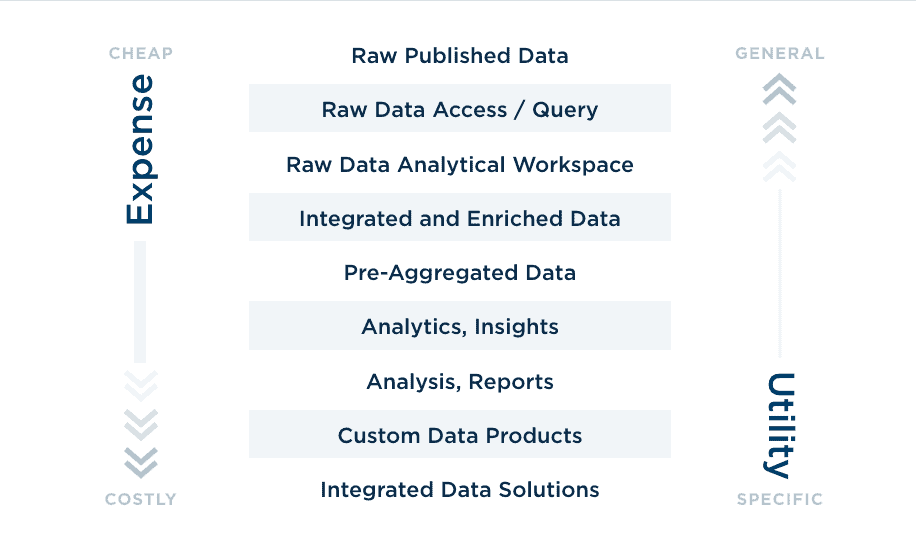
To put this in relatable terms, think about wheat. Few consumers (outside of a small number of processors) go to the fields to buy raw wheat. Most go to the store to buy wheat that’s processed into flour. Or, further along the value chain, they buy bread that has been baked from the processed flour or, a step further, a sandwich. At each step, the product is more consumable. The market becomes smaller, the cost becomes greater, but the value increases as you combine a raw material with other raw materials to make a product.
There are literally dozens of types of manufacturing data that may have value in some form of packaging along the spectrum above.

Getting Started or Back on Track
Whether you’re just starting or have explored data monetization but stalled, your organization will need an approach grounded in creating both momentum and value. Again, this is a process, not a one-time activity. It will also require a dedicated leader or team to own and support the process. West Monroe breaks data monetization into about a dozen discrete steps that fall into three basic phases:
1. Generate and prioritize ideas
2. Define the use case or data product requirements and features, collaboratively with stakeholders inside and outside of the business
3. Engineer, introduce, learn from the results and feedback, and improve continuously using rapid iterations to shorten the time to value
If this looks familiar, it is. It comes directly from well-honed R&D and product management playbooks.
Ideation workshops or exercises should start with your organization’s business drivers and identify those where you have the most potential for creating impact with data and analytics. Get a cross-functional group in a room to bring as many perspectives to the table as possible. And aim to develop as many ideas as possible.
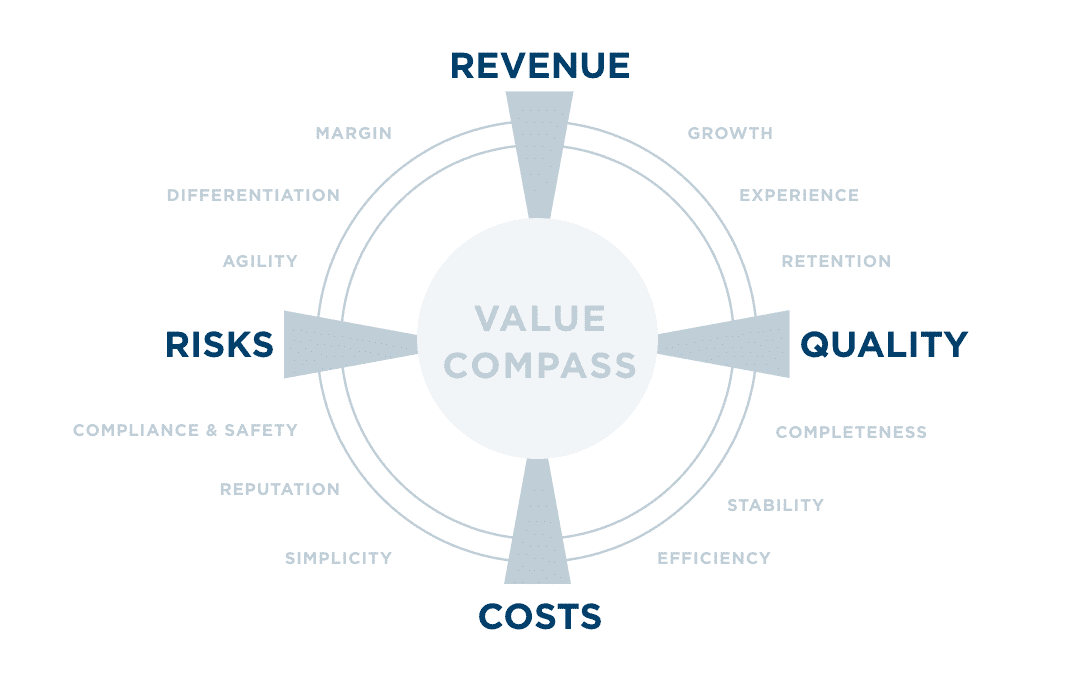
One way to frame an ideation exercise is to identify situations where it would be valuable to have more prescriptive, predictive, or diagnostic insight. In manufacturing, considerable effort still goes into reporting on the past—what was sold or how costs fluctuated last quarter. What’s more valuable is understanding why you only sold that much, how much you’re going to sell next quarter, or how you could sell even more.
Another potential starting point is to identify data with the greatest potential value inside and/or outside your organization. Characteristics of highly monetizable data include such things as degree of control or ownership, uniqueness (others do not have data like it), meaningful context, security, accuracy, and availability. If you have data that meets many of these characteristics, compartmentalize it and make sure you begin treating and managing it as an asset, even as you develop your strategy for monetizing it.
Take inspiration from what other organizations are doing, both in and beyond the manufacturing sector. We recommend referencing Data Juice for real-world stories, including several from consumer and industrial products organizations.
Finally, look for other business or IT initiatives already underway that can help in gathering, preparing, or using data in new ways. This is often a way to accelerate new initiatives that may otherwise be challenging to get off the ground.

“Characteristics of highly monetizable data include degree of control or ownership, uniqueness, meaningful context, security, accuracy, and availability. ”
As you begin to prioritize ideas, employ a feasibility assessment that considers factors such as complexity, cost, and magnitude of benefits. One way to compare and rank ideas is to plot them according to impact and complexity. Those with low complexity and high impact are candidates for rising to the top of the priority list.
Be prepared for bottlenecks
There will always be challenges—cultural, technical, poor data quality or governance, and privacy and legal considerations (perceived and real) among them. We often see organizational issues—including core business priorities that don’t encourage data monetization, accounting standards that don’t (yet) recognize data as an asset, and lack of experience and skills—as some of the biggest hurdles. At least some of these—such as building the right skills and foundational data integration, master data management, and storage or computing capacity—will require investment. It may pay to bring in expertise in areas such as data literacy, data management, and change management to accelerate key changes and avoid costly missteps.
And be ready to measure
As the old adage goes, you can’t manage what you don’t measure. Organizations tend to manage things like data volume and speed. Few measure data quality characteristics such as potential value, business relevancy, cost, impact on business performance, market value, and impact on the organization. Research shows that only 11% of organizations know the cost of their data, only 12% calculate the value of their data assets, and only 21% measure the business impact of data quality improvements. Further, only 4% have developed ways of measuring data value in monetary terms with an assigned dollar value, only 7% are now beginning to measure data value against data-driven services, and nearly a third don’t have measures in place to value the increasing volumes of data that digital technologies create.
If you’re going to proceed down the path of data monetization, you will need an approach for measuring the value. We recently worked with a client, a leading manufacturer of agricultural machinery, to develop an approach for understanding the return on its more than $100 million invested in data and advanced analytics capabilities and to justify new investments. This effort employed our thought leadership on the economics of information—or “infonomics”—to create a practical framework that the company is using to measure the value potential of digital and data products.
Ride the Wave
With the sudden emergence of generative AI, we believe people will someday remember 2023 in the same way we remember getting on the World Wide Web for the first time. This development has brought new attention to data and its potential value in all sectors, including data-rich manufacturing. We’ve seen interest in this sector pick up considerably in the past several months and expect that will only intensify as new capabilities emerge. If you are just beginning down the path toward data monetization or have started but stalled, now is the time to get focused. Manufacturers that do catch this wave and ride it to begin exploring data monetization will find themselves in a good position to benefit. M
About the authors:

Doug Laney, Innovation Fellow, Data & Analytics Strategy, West Monroe

David McGraw, Senior Manager, Consumer & Industrial Products, West Monroe

Tim Wrzesinski, Director, Technology, West Monroe
